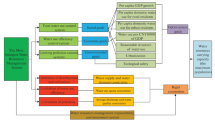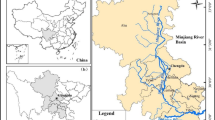Abstract
Allocating initial water rights is a prerequisite for implementing water rights trading and enhancing the water use efficiency. This paper investigates the establishment of a model for allocating basin-wide initial water rights considering both the quantity and quality of water. First, a new concept, two-dimensional water rights, is presented and described in the paper. Second, the initial water rights allocation model, which maximizes the harmonious degree of an entire water system, is developed based on five principles: (1) the basic water demands, (2) fairness, (3) respect for the status quo, (4) economic efficiency, and (5) the unification of water withdrawals and sewage discharge. Third, the proposed model is applied to the Beijiang River Basin in southern China, and the model validity and reasonability of the presented two-dimensional water rights allocation scheme are verified via comparisons with other allocation patterns. Finally, several conclusions are presented.



Similar content being viewed by others
References
Brown, C. M., Lund, J. R., Cai, X., Reed, P. M., Zagona, E. A., Ostfeld, A., et al. (2015). The future of water resources systems analysis: toward a scientific framework for sustainable water management. Water Resources Research, 51, 6110–6124.
Archibald, T. W., & Marshall, S. E. (2018). Review of mathematical programming applications in water resource management under uncertainty. Environmental Modeling and Assessment, 23(6), 753–777.
Montanari, A., Bahr, J., Blöschl, G., Cai, X., Mackay, D. S., Michalak, A. M., et al. (2015). Fifty years of water resources research: legacy and perspectives for the science of hydrology. Water Resources Research, 51, 6797–6803.
Poff, N. L., Brown, C. M., Grantham, T. E., Matthews, J. H., Palmer, M. A., Spence, C. M., et al. (2016). Sustainable water management under future uncertainty with eco-engineering decision scaling. Nature Climate Change, 6(1), 25–34.
Li, Y. P., Huang, G. H., & Nie, S. L. (2009). Water resources management and planning under uncertainty: an inexact multistage joint-probabilistic programming method. Water Resources Management, 23(12), 2515–2538.
Lund, J. R. (2015). Integrating social and physical sciences in water management. Water Resources Research, 51, 1–14.
Hu, S., Wang, Z., Wang, Y., & Zhang, L. (2010). Total control-based unified allocation model for allowable basin water withdrawal and sewage discharge. SCIENCE CHINA Technological Sciences, 53(5), 1387–1397.
Wang, Z., Zheng, H., & Wang, X. (2009). A harmonious water rights allocation model for Shiyang River Basin, Gansu Province, China. International Journal of Water Resources Development, 25(2), 355–371.
Zheng, H., Wang, Z., Calow, R., & Wei, Y. (2012). Water rights allocation, management and trading in an irrigation district - a case study of northwestern China. In K. Manish (Ed.), Problems, Perspectives and Challenges of Agricultural Water Management (1st ed., pp. 65–88). InTech.
Liu, C., & Zheng, H. (2002). South-to-north water transfer schemes for China. International Journal of Water Resources Development, 18(3), 453–471.
Burness, H. S., & Quirk, J. P. (1979). Appropriative water rights and the efficient allocation of resources. American Economic Review, 69(1), 25–37.
Grantham, T. E., & Viers, J. H. (2014). 100 years of California’s water rights system: patterns, trends and uncertainty. Environmental Research Letters, 9(8), 084012.
Wong, B. D. C., & Eheart, J. W. (1983). Market simulations for irrigation water rights: a hypothetical case study. Water Resources Research, 19(5), 1127–1138.
Hendry, S. (2014). Water rights and allocation. In Frameworks for Water Law Reform (International Hydrology Series, pp. 35–56). Cambridge: Cambridge University Press. https://doi.org/10.1017/CBO9780511998065.003
Erkun Gao. (2007). China’s water right system development. Beijing (in Chinese): China Water Power Press.
Commission, P. (2003). Water rights arrangements in Australia and overseas. SSRN Electronic Journal. https://doi.org/10.2139/ssrn.496882.
Bird, J., Arriens, W. L., & Custodio, D. Von. (2009). Water rights and water allocation issues and challenges for Asia 17. Asian Development Bank, 1–76.
Shen, D., & Speed, R. (2009). Water resources allocation in the People’s Republic of China. International Journal of Water Resources Development, 25(2), 209–225.
Wang, L., Fang, L., & Hipel, K. W. (2007). Mathematical programming approaches for modeling water rights allocation. Journal of Water Resources Planning and Management, 133(2), 50–59.
Hazelett, E. (2013). The evolution of water law toward the efficient allocation of water rights: an analysis of England and California. Wesleyan University.
Dellapenna, J. W., & Gupta, J. (2009). The evolution of global water law. In J. W. Dellapenna & J. Gupta (Eds.), The Evolution of the Law and Politics of Water (pp. 3–20). Springer Science + Business Media B.V.
Wu, K. Y., & Wu, D. N. (2014). Evolution of the relationship between economic development and water pollution in Shanghai. In Resources and Sustainable Development III (Vol. 962, pp. 2031–2039). Trans Tech Publications.
Karamouz, M., Mojahedi, S. A., & Ahmadi, A. (2010). Interbasin water transfer: economic water quality-based model. Journal of Irrigation and Drainage Engineering, 136(2), 90–98.
Shahpouri, A., Biabi, H., & Abolhassani, L. (2016). Economic development and environmental quality: the environmental Kuznets curve for water pollution. Journal of Applied Sciences and Environmental Management, 20(1), 161–169.
Zuo, Q., Jin, R., Ma, J., & Cui, G. (2014). China pursues a strict water resources management system. Environmental Earth Sciences, 72(6), 2219–2222.
Zuo, Q., Liu, H., Ma, J., & Jin, R. (2016). China calls for human-water harmony. Water Policy, 18(2), 255–261.
Yang, Y. E., Zhao, J., Cai, X., & Asce, M. (2011). Decentralized optimization method for water allocation management in the Yellow River basin. Journal of Water Resources Planning and Management, 138(8), 313–325.
Kumphon, B. (2013). Genetic algorithms for multi-objective optimization: application to a multi-reservoir system in the Chi River Basin, Thailand. Water Resources Management, 27(12), 4369–4378.
Tic, E. I., Popa, B., & Popa, R. (2017). Annual performance estimation of a multireservoir system including a pumped storage plant for the mean hydrological year. Journal of Energy Engineering, 143(6), 1–10.
Oliveira, R., & Loucks, D. P. (1997). Operating rules for multireservoir systems. Water Resources Research, 33(4), 839–852.
Van Der Zaag, P., Seyam, I. M., & Savenije, H. H. G. (2002). Towards measurable criteria for the equitable sharing of international water resources. Water Policy, 4(1), 19–32.
Jin, J., Cheng, J., & Wei, Y. (2007). Minimum relative information entropy method for determining weights of region water resources allocation. Journal of Hydroelectric Engineering, 26(1), 28–32.
Espinoza, F. P., Minsker, B. S., & Goldberg, D. E. (2005). Adaptive hybrid genetic algorithm for groundwater remediation design. Journal of Water Resources Planning and Management, 131(1), 14–24.
Millia, J., Delhi, N., Bonin, O., & Rousseaux, F. (2000). Multireservoir systems optimization using genetic algorithms: case study. Journal of Computing in Civil Engineering, 14(4), 255–263.
Hinçal, O., Altan-Sakarya, A. B., & Ger, A. M. (2011). Optimization of multireservoir systems by genetic algorithm. Water Resources Management, 25(5), 1465–1487.
Zargar, M., Samani, H. M. V., & Haghighi, A. (2016). Optimization of gated spillways operation for flood risk management in multi-reservoir systems. Natural Hazards, 82(1), 299–320.
The Pearl River Water Resources Commission of the Ministry of Water Resources of China. (2013). The general water resources planning of Beijiang river basin. Guangzhou(in Chinese).
Wang, Z., Zhang, L., Wang, Y., Jin, J., & Cheng, L. (2012). Preliminary theoretical framework of water resources operation based on initial two-dimensional water rights in a basin. Advances in Water Science, 23(4), 590–597 (in Chinese).
Acknowledgments
We would like to thank the anonymous reviewers for their helpful comments.
Funding
This research was supported financially by the National Key Research and Development Program of China (2018YFC0408005), the National Natural Science Foundation of China (51579064), and the Provincial Water Conservancy Research Program (SDSLKY201809).
Author information
Authors and Affiliations
Corresponding authors
Ethics declarations
Conflict of Interest
The authors declare that they have no conflicts of interest.
Human and animal rights and informed consent
This research does not involve human participants or animals.
Additional information
Publisher’s Note
Springer Nature remains neutral with regard to jurisdictional claims in published maps and institutional affiliations.
Rights and permissions
About this article
Cite this article
Wang, Z., Zhang, L., Cheng, L. et al. Basin-Wide Initial Water Rights Allocation Model Considering Both the Quantity and Quality of Water. Environ Model Assess 25, 581–589 (2020). https://doi.org/10.1007/s10666-020-09709-7
Received:
Accepted:
Published:
Issue Date:
DOI: https://doi.org/10.1007/s10666-020-09709-7




